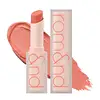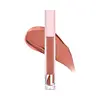What's inside
What's inside
 Key Ingredients
Key Ingredients

 Benefits
Benefits

 Concerns
Concerns

 Ingredients Side-by-side
Ingredients Side-by-side

Dimethicone
EmollientIsoamyl Laurate
EmollientDiisostearyl Malate
EmollientDiphenyl Dimethicone/Vinyl Diphenyl Dimethicone/Silsesquioxane Crosspolymer
CI 77891
Cosmetic ColorantIsononyl Isononanoate
EmollientVinyl Dimethicone/Methicone Silsesquioxane Crosspolymer
Polyethylene
AbrasiveIsoeicosane
EmollientEthylhexyl Hydroxystearate
EmollientSilica
AbrasiveHydrogenated Polyisobutene
EmollientPolyglyceryl-2 Triisostearate
EmulsifyingMicrocrystalline Wax
Emulsion StabilisingDimethicone Crosspolymer
Emulsion StabilisingParaffin
PerfumingDiglyceryl Sebacate/Isopalmitate
EmollientCI 77492
Cosmetic ColorantCI 77491
Cosmetic ColorantSodium Hyaluronate
HumectantGossypium Herbaceum Seed Extract
Skin ConditioningSorbitan Isostearate
EmulsifyingVp/Hexadecene Copolymer
Polyhydroxystearic Acid
EmulsifyingTriethoxycaprylylsilane
Polyglyceryl-2 Diisostearate
EmulsifyingEthylhexyl Palmitate
EmollientIsopropyl Myristate
EmollientIsostearic Acid
CleansingLecithin
EmollientPolyglyceryl-3 Polyricinoleate
EmulsifyingPentaerythrityl Tetra-Di-T-Butyl Hydroxyhydrocinnamate
AntioxidantButylene Glycol
HumectantWater
Skin ConditioningGlycerin
HumectantSilica Dimethyl Silylate
EmollientCaprylyl Glycol
EmollientHexylene Glycol
EmulsifyingPhenoxyethanol
PreservativeCI 19140
Cosmetic ColorantCI 15850
Cosmetic ColorantCI 45410
Cosmetic ColorantCI 77499
Cosmetic ColorantDimethicone, Isoamyl Laurate, Diisostearyl Malate, Diphenyl Dimethicone/Vinyl Diphenyl Dimethicone/Silsesquioxane Crosspolymer, CI 77891, Isononyl Isononanoate, Vinyl Dimethicone/Methicone Silsesquioxane Crosspolymer, Polyethylene, Isoeicosane, Ethylhexyl Hydroxystearate, Silica, Hydrogenated Polyisobutene, Polyglyceryl-2 Triisostearate, Microcrystalline Wax, Dimethicone Crosspolymer, Paraffin, Diglyceryl Sebacate/Isopalmitate, CI 77492, CI 77491, Sodium Hyaluronate, Gossypium Herbaceum Seed Extract, Sorbitan Isostearate, Vp/Hexadecene Copolymer, Polyhydroxystearic Acid, Triethoxycaprylylsilane, Polyglyceryl-2 Diisostearate, Ethylhexyl Palmitate, Isopropyl Myristate, Isostearic Acid, Lecithin, Polyglyceryl-3 Polyricinoleate, Pentaerythrityl Tetra-Di-T-Butyl Hydroxyhydrocinnamate, Butylene Glycol, Water, Glycerin, Silica Dimethyl Silylate, Caprylyl Glycol, Hexylene Glycol, Phenoxyethanol, CI 19140, CI 15850, CI 45410, CI 77499
Dimethicone
EmollientDimethicone/Vinyl Dimethicone Crosspolymer
Skin ConditioningLauryl Dimethicone
Skin ConditioningTrimethylsiloxysilicate
EmollientC30-45 Alkyl Dimethicone
Skin ConditioningStearyl Dimethicone
EmollientVinyl Dimethicone/Methicone Silsesquioxane Crosspolymer
Polysilicone-11
Phenyl Trimethicone
Skin ConditioningSynthetic Wax
AbrasiveC12-15 Alkyl Benzoate
AntimicrobialOctyldodecanol
EmollientDisteardimonium Hectorite
StabilisingDicalcium Phosphate
AbrasiveLaureth-4
EmulsifyingCaprylic/Capric Triglyceride
MaskingPolyhydroxystearic Acid
EmulsifyingMica
Cosmetic ColorantPropylene Carbonate
SolventAroma
Isostearic Acid
CleansingPentaerythrityl Tetra-Di-T-Butyl Hydroxyhydrocinnamate
AntioxidantLecithin
EmollientPolyglyceryl-3 Polyricinoleate
EmulsifyingTin Oxide
AbrasiveCI 77891
Cosmetic ColorantIron Oxides
CI 19140
Cosmetic ColorantCI 15850
Cosmetic ColorantCI 15985
Cosmetic ColorantCI 42090
Cosmetic ColorantCI 45410
Cosmetic ColorantDimethicone, Dimethicone/Vinyl Dimethicone Crosspolymer, Lauryl Dimethicone, Trimethylsiloxysilicate, C30-45 Alkyl Dimethicone, Stearyl Dimethicone, Vinyl Dimethicone/Methicone Silsesquioxane Crosspolymer, Polysilicone-11, Phenyl Trimethicone, Synthetic Wax, C12-15 Alkyl Benzoate, Octyldodecanol, Disteardimonium Hectorite, Dicalcium Phosphate, Laureth-4, Caprylic/Capric Triglyceride, Polyhydroxystearic Acid, Mica, Propylene Carbonate, Aroma, Isostearic Acid, Pentaerythrityl Tetra-Di-T-Butyl Hydroxyhydrocinnamate, Lecithin, Polyglyceryl-3 Polyricinoleate, Tin Oxide, CI 77891, Iron Oxides, CI 19140, CI 15850, CI 15985, CI 42090, CI 45410
Ingredients Explained
These ingredients are found in both products.
Ingredients higher up in an ingredient list are typically present in a larger amount.
Ci 15850 is the pigment color red. It is an azo dye and created synthetically.
Azo dyes need to be thoroughly purified before use. This allows them to be more stable and longer-lasting.
This ingredient is common in foundations, lipsticks, and blushes. This color is described as brown/orangey red.
It has many secondary names such as Red 6 and Red 7. According to a manufacturer, Red 6 usually contains aluminum.
Learn more about CI 15850CI 19140 is also known as Tartrazine. Tartrazine is a synthetic dye used in cosmetics, foods, and medicine to add a yellow color.
Tartrazine is created from petroleum and is water-soluble.
Some people may experience allergies from this dye, especially asthmatics and those with an aspirin intolerance.
Learn more about CI 19140CI 45410 is a synthetic red-pigment and dye.
It often goes by both Red 28 or Red 27; manufacturers label both ingredients as CI 45410.
This dye is commonly found in makeup because it imparts a vivid color. Some types of this dye change color based on pH level and interaction with moisture:
Your skin has a natural pH of around 4.5 - 5.5.
According to the FDA, CI 45410 is not permitted for use in eye products.
Red 27 is a flourescein dye and commonly used as a fluorescent tracer in medicine.
Learn more about CI 45410Ci 77891 is a white pigment from Titanium dioxide. It is naturally found in minerals such as rutile and ilmenite.
It's main function is to add a white color to cosmetics. It can also be mixed with other colors to create different shades.
Ci 77891 is commonly found in sunscreens due to its ability to block UV rays.
Learn more about CI 77891Dimethicone is a type of synthetic silicone created from natural materials such as quartz.
What it does:
Dimethicone comes in different viscosities:
Depending on the viscosity, dimethicone has different properties.
Ingredients lists don't always show which type is used, so we recommend reaching out to the brand if you have questions about the viscosity.
This ingredient is unlikely to cause irritation because it does not get absorbed into skin. However, people with silicone allergies should be careful about using this ingredient.
Note: Dimethicone may contribute to pilling. This is because it is not oil or water soluble, so pilling may occur when layered with products. When mixed with heavy oils in a formula, the outcome is also quite greasy.
Learn more about DimethiconeIsostearic acid is a saturated fatty acid. Its structure makes it a great surfactant.
Surfactants help decrease the surface tension between two liquids. This property also makes it an effective emulsifier. Emulsifiers help prevent waters and oils from separating in a product.
Isostearic Acid is created from oleic acid.
This ingredient may not be Malassezia folliculitis, or fungal-acne safe.
Learn more about Isostearic AcidLecithin is a term for a group of substances found in the cell membranes of plants, animals, and humans. They are made up of mixture of phospholipids.
This ingredient has emollient and emulsifying properties.
As an emollient, lecithen helps soften the skin and creates a barrier to keep moisture in.
As an emulsifier, it also helps prevent water and oil ingredients from separating. Lecithin can also help ingredients be better absorbed by the skin.
This is because the phospholipids in lecithin produce liposomes. Liposomes help other ingredients get through the skin barrier.
Depending on the source of this ingredient, lecithin may not be fungal acne safe. This is because some sources of lecithin come from soybean oil, which may feed the malassezia yeast that feeds fungal acne.
We recommend reaching out to the brand you are purchasing from to inquire about the source of their lecithin.
Some other names for this ingredient include soy lecithin and deoiled soy lecithin.
Learn more about LecithinPentaerythrityl Tetra-Di-T-Butyl Hydroxyhydrocinnamate (long name, huh?) is a synthetic antioxidant.
It is used to help stabilize other antioxidants or prevent the color from changing in a product.
As an antioxidant, it helps fight free-radical molecules. Free-radical molecules are capable of damaging our cells and other genetic material. Thus, antioxidants may reduce the signs of aging.
This ingredient is oil-soluble.
Learn more about Pentaerythrityl Tetra-Di-T-Butyl HydroxyhydrocinnamateThis ingredient is an emulsifier. It is created from Polyglycerin-3 and Ricinoleic Acid.
As an emulsifier, it prevents waters and oils from separating. According to a manufacturer this ingredient is fully biodegradable.
This ingredient may not be safe for Malassezia folliculitis due to its Ricinoleic Acid base. Ricinoleic Acid is a fatty acid derived from castor oil.
Learn more about Polyglyceryl-3 PolyricinoleatePolyhydroxystearic Acid is a soft wax made from castor oil.
It is is a texture thickener, emulsifier, and film-former. Emulsifiers prevent ingredients from separating, such as oils and waters.
Polyhydroxystearic Acid may not be fungal acne safe.
Learn more about Polyhydroxystearic AcidThis ingredient is used in makeup and skincare to thicken formulas, reduce shine, and give skin a silky-smooth feel.
It’s a white silicone powder that sits in fine lines and pores to blur their appearance though its effectiveness depends on the particle size.
You'll typically find this ingredient in amounts between 0.1-20%.
Learn more about Vinyl Dimethicone/Methicone Silsesquioxane Crosspolymer